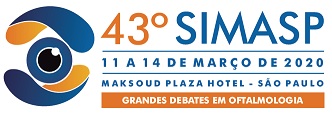Dados do Trabalho
Título
INFECTIOUS KERATITIS FOLLOWING CORNEAL TRANSPLANTATION
Introdução
To evaluate microbiological and clinical profile of infectious keratitis cases following corneal transplantation at Ophthalmology and Visual Sciences Department at Escola Paulista de Medicina – UNIFESP
Métodos
A retrospective study was conducted among patients who had samples sent to the Ophthalmic Microbiology Laboratory from the 1st of January 2014 to the 31th of December 2018. All patients with history of corneal transplantation were selected. Data regarding age, gender, time lapse from the corneal transplant, etiologic agent and antimicrobial resistance profile were collected. Keratitis from tectonic corneal transplantations were excluded from the study.
Resultados
From an overall of 177 samples sent to Ophthamic Microbiology Laboratory during the studied period, 3 were cases of limbal transplantation and 12 were from tectonic corneal transplantation. The remaining 162 samples were selected with a history of previous corneal transplantation with a positive culture. Median age was 55.50 (SD ±22.21). Male to female ratio was 1.17 : 1.00. Use of antibiotic drops (mainly moxifloxacin) was present in 32.71% of the patients and use of an immunomodulator (prednisolone acetate or tacrolimus) in 19.75% at the time of the sample collection. 89.84% from the keratitis arised from corneal grafts with more than 60 days from the transplantation surgery, 7.62% from grafts between 14 and 60 days from the transplantation and 2,54% from grafts with less than 14 days. Bacterial isolates accounted for the majority of the cases (93.84%), followed by fungal (3.70%) and parasitic (2.46%) isolates. Among bacterial keratitis cases, most frequent pathogens were coagulase negative Staphylococcus (46.91%), Streptococcus spp (12.96%), Staphylococcus aureus (11.11%) and Pseudomonas spp (8.02%). Antimicrobial resistance profile analysis showed that only 61.72% of the samples were sensitive to moxifloxacin.
Conclusões
Bacteria were the main isolates from infectious keratitis following corneal transplantation. Microbiological findings of the present study are important to determine whether current standardized empiric protocols at our institution are adequate to manage infectious keratitis following corneal transplantation.
Palavras Chave
Corneal transplant; keratitis; epidemiology.
Arquivos
Área
Patologia Clínica
Instituições
Escola Paulista de Medicina - São Paulo - Brasil
Autores
JOSÉ ARTHUR PINTO MILHOMENS FILHO, ALINE SILVEIRA MORIYAMA, MARIA CECILIA ZORAT YU, ANA LUISA HÖFLING-LIMA
